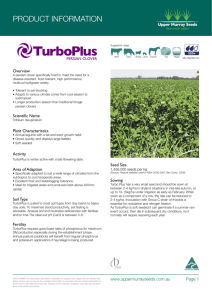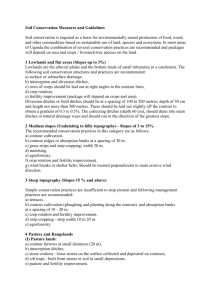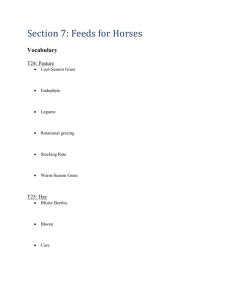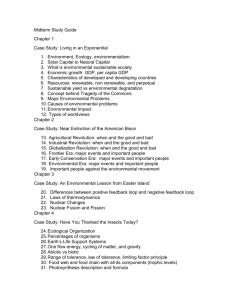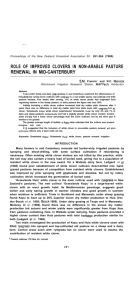Soil Testing Without Labs by Dr Tim Jenkins, Biological
advertisement
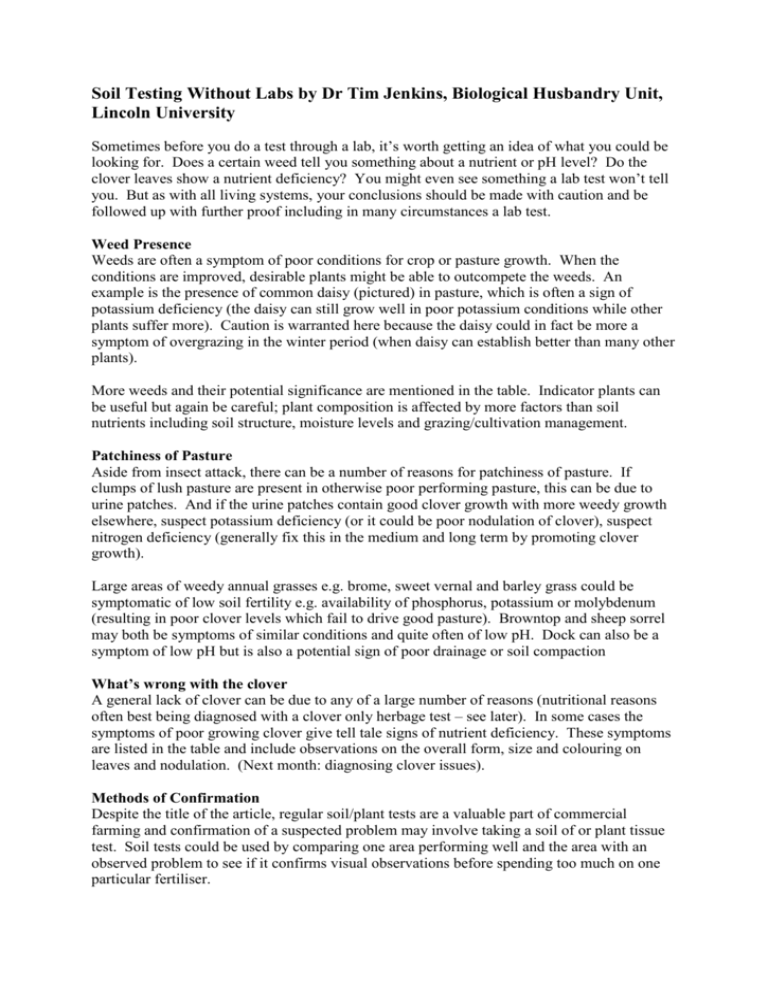
Soil Testing Without Labs by Dr Tim Jenkins, Biological Husbandry Unit, Lincoln University Sometimes before you do a test through a lab, it’s worth getting an idea of what you could be looking for. Does a certain weed tell you something about a nutrient or pH level? Do the clover leaves show a nutrient deficiency? You might even see something a lab test won’t tell you. But as with all living systems, your conclusions should be made with caution and be followed up with further proof including in many circumstances a lab test. Weed Presence Weeds are often a symptom of poor conditions for crop or pasture growth. When the conditions are improved, desirable plants might be able to outcompete the weeds. An example is the presence of common daisy (pictured) in pasture, which is often a sign of potassium deficiency (the daisy can still grow well in poor potassium conditions while other plants suffer more). Caution is warranted here because the daisy could in fact be more a symptom of overgrazing in the winter period (when daisy can establish better than many other plants). More weeds and their potential significance are mentioned in the table. Indicator plants can be useful but again be careful; plant composition is affected by more factors than soil nutrients including soil structure, moisture levels and grazing/cultivation management. Patchiness of Pasture Aside from insect attack, there can be a number of reasons for patchiness of pasture. If clumps of lush pasture are present in otherwise poor performing pasture, this can be due to urine patches. And if the urine patches contain good clover growth with more weedy growth elsewhere, suspect potassium deficiency (or it could be poor nodulation of clover), suspect nitrogen deficiency (generally fix this in the medium and long term by promoting clover growth). Large areas of weedy annual grasses e.g. brome, sweet vernal and barley grass could be symptomatic of low soil fertility e.g. availability of phosphorus, potassium or molybdenum (resulting in poor clover levels which fail to drive good pasture). Browntop and sheep sorrel may both be symptoms of similar conditions and quite often of low pH. Dock can also be a symptom of low pH but is also a potential sign of poor drainage or soil compaction What’s wrong with the clover A general lack of clover can be due to any of a large number of reasons (nutritional reasons often best being diagnosed with a clover only herbage test – see later). In some cases the symptoms of poor growing clover give tell tale signs of nutrient deficiency. These symptoms are listed in the table and include observations on the overall form, size and colouring on leaves and nodulation. (Next month: diagnosing clover issues). Methods of Confirmation Despite the title of the article, regular soil/plant tests are a valuable part of commercial farming and confirmation of a suspected problem may involve taking a soil of or plant tissue test. Soil tests could be used by comparing one area performing well and the area with an observed problem to see if it confirms visual observations before spending too much on one particular fertiliser. Taking a clover only herbage test is a good way of finding (or getting further confirmation on) nutritional deficiencies that are holding back clover and therefore the whole pasture. Select only clover that shows the symptoms of the problems rather than healthy looking clover that may be present in patches. With crops, it may be worth taking a sample of an area of good performing crop to compare with an area of poor performing crop of the same type and planting time. In most cases, there are big differences in nutrient levels according to time of year and age of plant as well as the type of leaves sampled so follow lab instructions precisely if relying on lab recommended values. Experimenting A more direct method of confirming an observation is to actually apply the element or otherwise address the suspected issue. This can be done by treating a strip or larger area of pasture or crop and hoping for a visual response compared to the surrounding untreated area. Unless the experiment is replicated you may never be sure that the treatment was truly effective but if the result is dramatic it should give you good confidence. Sustainable Farming Fund - Small Farmer Workshops P.S. The BHU Small Farmer Workshops are underway. Email jenkint2@lincoln.ac.nz / phone 03 3253684 for info on the monthly workshops especially relevant but not restricted to organics on topics including composting, fruit tree pruning, organic weed control and exporting. Weed Species Annual Meadow Grass (Poa) Possible Soil Implications High N (if urine scorch present from high protein) Barley Grass High N Browntop Low pH, Low Nitrogen, Low Phosphorus, Low Potassium, Low Molybdenum, low fertility generally Low N, moderate fertility generally Low K, Low P, Low fertility generally Californian thistle Cats ear Chickweed Couch or Twitch Creeping Buttercup Daisy Dandelion High fertility, though low fertility if this has caused bare patches Low soil biological activity, Low Ca, High N Poor drainage, Low N Low Potassium, low fertility generally, poor drainage Low fertility generally (but not always an undesirable Other Possible Reasons Quickly taking advantage of bare patches, dry conditions, pugging Dry conditions, disturbed areas e.g. stock camps, tracks, overgrazing in summer or autumn Undergrazing, spread by cultivation and by late hay cuts Under grazing in summer, over grazing in winter Overgrazing, frequent hay cutting, insect damaged pasture Quickly taking advantage of bare patches, relatively dry conditions, well aerated Overgrazing in summer, undergrazing in autumn, hay cutting Horse grazing Overgrazing in Winter Overgrazing, cold winters Dock Fathen Rushes Sheep Sorrel Stinging Nettle Sweet Vernal Yorkshire Fog plant), friable Poor Drainage, Compaction, Acid Soil, High Nitrogen High N, friable Poor drainage, Low pH Low pH, Low fertility generally High N, friable Low Potassium, Low fertility generally, Low friability Low N, Low pH, Low fertility generally excessive trampling, preferential grazing (esp. cattle not eating it), shortterm pastures cut for silage, seed spread from effluent applications or infested hay Dry conditions, bare patches Pugging, wet conditions Overgrazing in summer, hay cutting, overcropping Recently disturbed fallow ground Unimproved, declining pastures Undergrazing Caption for Photo: Daisies in the pasture – low potassium or too much winter grazing?
